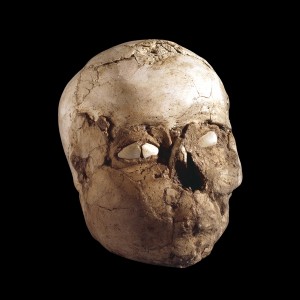
Plastered skull now in the collection of the British Museum, from Jericho, Israel, 7000-6000 BC. Photo credit: British Museum
Dr. Kroucher’s talk discussed the plastered skulls sometimes found in burials across the Near Eastern Neolithic, at sites including Ein Ghazal and Chatalhoyuk. Approximately 90 skulls have been recovered from across the Near East where the skull of an individual has been plastered over after death and decomposition. Some plastered skulls have shells or stones in place for eyes, and sometimes colourings such as browns or pinks were used probably to make the skull look more life-like. An absence of plaster on most skulls where hair would have been has led some researchers to suggest that wigs or hair may have been attached to the skulls. The reasons for some skulls being plastered and displayed are unclear and Dr. Kroucher’s research questions related to understanding the practice of skull-plastering and whether we can use contemporary theories of grief and mourning to inform on past mortuary practices.
Traditional explanations for plastered skulls typically suggest that higher status individuals, or ritual or ancestral leaders were preserved in this manner, sometimes to unite the community or to mask social inequality. However statistics indicate that many of the plastered skulls were likely juvenile or sub-adult, although compiling statistics from a number of different researchers who use varied sexing and ageing norms can be problematic.
Dr. Kroucher’s explanations for the plastered skulls were drawn partly from her recent experiences visiting in palliative care, although she noted that applying modern western cultural models to the archaeology of the ancient Near Eastern Neolithic may be problematic. She suggested that in some cases the plastered skulls were displayed and/or extensively handled after death and plastering, indicating that perhaps skull plastering was a method of trying to keep the dead close to the living. She noted that many different ethnographic cultures attempt to keep the dead near them, including the Victorians who had a practice of photographing dead children (“If you’re bored at lunchtime, google ‘photographic images of dead Victorian children’”) and modern culture where various modern technologies may be used to keep the dead nearby, including cremation tattoos where the ash of the deceased is mixed with tattoo ink, and jewellery made from cremated ashes. The application of the “archaeology meets palliative care” model of Dr. Kroucher’s research does appear to have aided our understanding of ancient mortuary practices.
Photo credit: British Museum
Written by Sheahan Bestel
